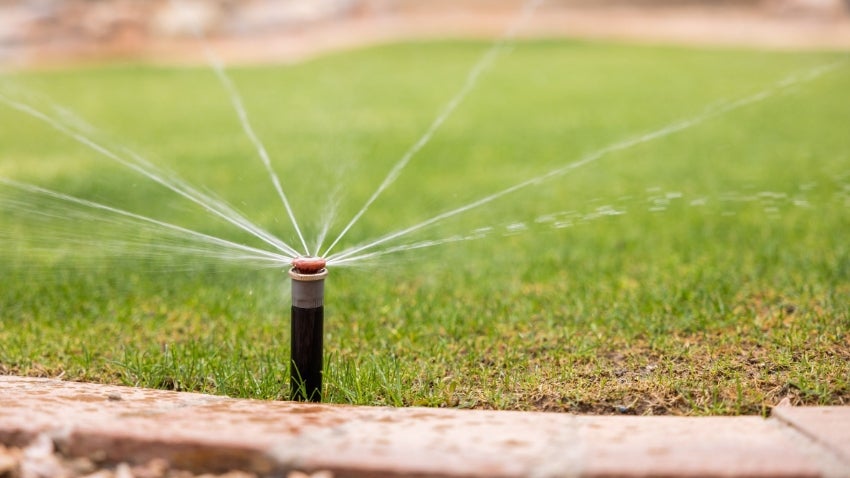
Keeping grass green and attractive in the low desert can be a difficult task. It’s not just about water. Fifty to seventy percent of household water use is outdoors, and with grass being the thirstiest plant in the landscape, you will want to make sure you are following the best practices to keep it healthy without wasting our most precious resource.
One way to make sure your lawn is prepared for high temps is to train the roots to grow deep.
Grass roots grow where the soil is moist. Watering your lawns everyday will only moisten the top few inches of soil causing shallow roots. Change your watering schedule to establish deeper roots that will help it survive the summer heat. Watering deeply (at least 6 inches) allows the moisture to remain in the root zone longer so you don’t need to water as often. Watering your lawn 2 times a week in the summer is all it needs.
Tips to Make Sure Your Lawn is Efficiently Maintained
- Does your grass need water? Do the walk test by walking on the grass. If footprints remain a few minutes later, it’s time to water.
- Water at night. Make sure you only water when the sun is down or during the cool morning hours to reduce evaporation losses. Many irrigation experts feel the best time to water is between sunset and 6 a.m. because evaporation is kept to a minimum.
- Repair irrigation leaks. Turn your controller on manually and walk your property looking for broken sprinkler heads, missing emitters (that produce small streams of water) or breaks in irrigation piping or tubing. Details on finding irrigation leaks can be found in the Smart Home Water Guide.
- Use slow-release fertilizers. Heavily fertilized lawns use more water and are more susceptible to heat stress. Products with nitrogen will generate stem and blade growth that may lead to frequent mowing. To green up the lawn without excessive growth try slow-release fertilizers or those with water soluble (chelated) iron.
- Mow properly. Remove only 1/3 of the grass length when mowing. Cutting too much at once stresses the grass. Mow tall to shade the soil and reduces soil water loss from evaporation. Leave the clippings on the lawn. "Grasscycling" is provides free fertilizer (at least ¼ of your lawn’s needs) that helps lawns grow greener, denser, and doesn’t cause thatch buildup. For best results, keep the blade sharp and mow when the grass is dry. Clippings left scattered on the surface will break down quickly; if there are clumps mow again to break them up.
- Dethatch your yard. A layer of stems, roots and leaves called thatch, can accumulate between the vegetation and soil causing grass roots to quickly dry out requiring more water to maintain. A thin layer is okay, but too much will repel water. Excessive thatch is caused by over fertilizing or over watering, especially if you have a hybrid Bermuda lawn. Check your lawn by digging a pie shaped wedge of grass and soil. If the thatch layer exceeds ½ inch, it’s time to dethatch your lawn. Dethatch during the summer months so your Bermuda grass can recover quickly. You can rent a vertical cutting mower, power rake or hire a professional lawn care company. Remove clippings and thatch debris immediately after dethatching.
- Aerate your lawn.Aeration will improve water penetration and encourage deeper roots. Soil plugs produced by aeration should be left on the lawn as they help to decompose thatch.
- Inspect and fine-tune your sprinklers system. When your watering system is running, look for and adjust sprinklers to ensure they are only spraying on the grass and not sidewalks, block walls, or driveways which can undermine and weaken walls and concrete.
- Remove weeds.Hand pull weeds as they appear. They will rob your lawn of water and nutrients, and push out the desirable grasses. If you prefer to treat instead of pull weeds, use a pre-emergent herbicide. To be effective, these materials must be applied prior to germination of the weed seeds.
- Don’t overwater. Grass is the thirstiest plant in the landscape, but it does not need to be watered more than two times a week in the summer and less as the weather cools. Reduce water waste; learn how to prevent water runoff from the lawn into the street.
Using proper soil preparation and lawn maintenance practices will build healthy soil and vigorous, deep-rooted lawns. These lawns are drought tolerant, more resistant to disease and insects, and will out-compete most weeds.
Conserving Water in Your Lawn
An efficient way to conserve water during winter is by going blonde or you may want to consider removing your grass. Too much work? Hire a landscape contractor.
For more information email the Chandler Water Conservation office.



